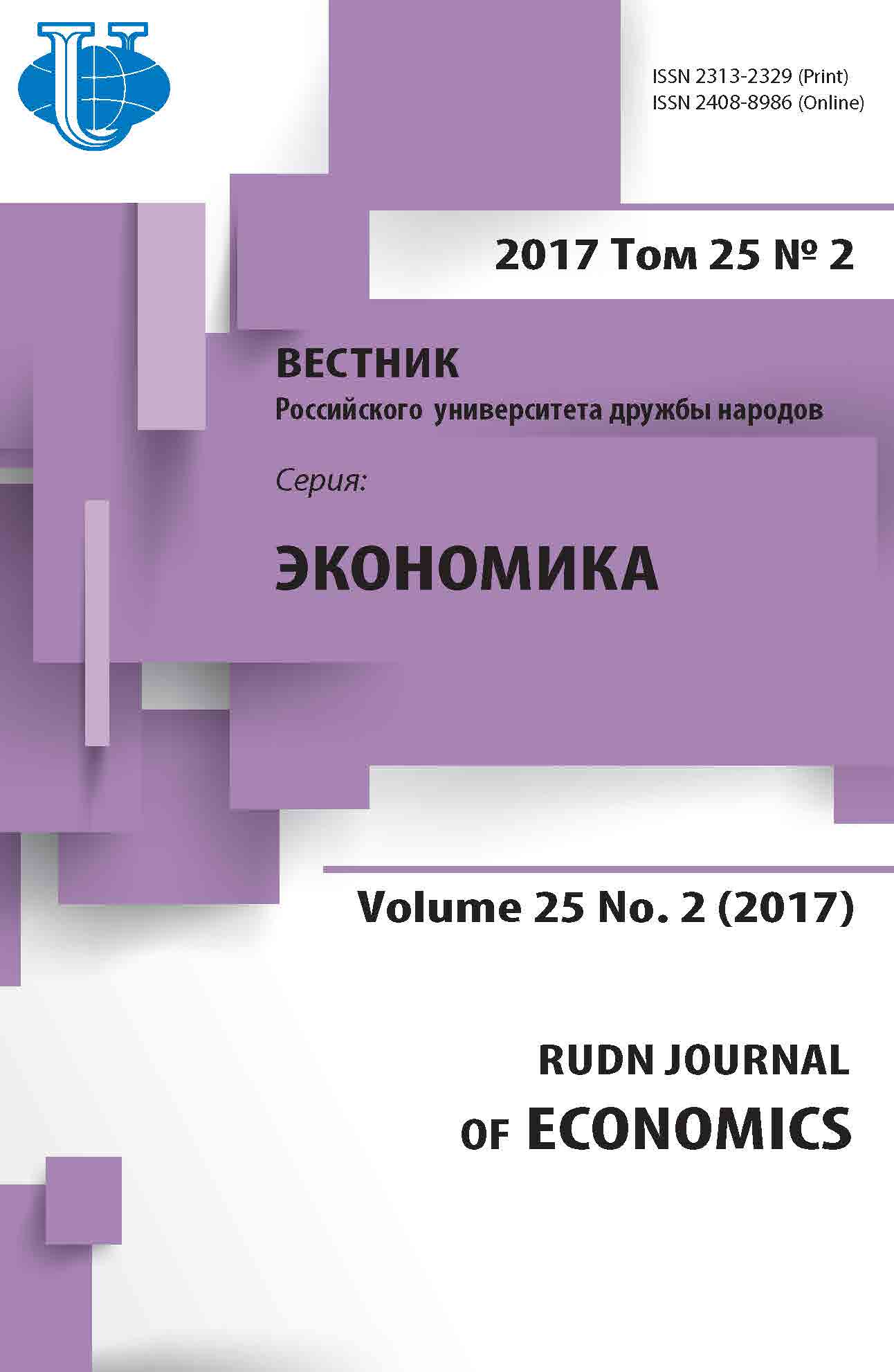REGIONAL INTEGRATION IN AFRICA: DYNAMICS OF INTRA-REGIONAL TRADE 1990-2015
- Authors: Diabate V1, Kholina VN1
-
Affiliations:
- Peoples’ Friendship University of Russia
- Issue: Vol 25, No 2 (2017)
- Pages: 159-167
- Section: Articles
- URL: https://journals.rudn.ru/economics/article/view/17156
- DOI: https://doi.org/10.22363/2313-2329-2017-25-2-159-167
Cite item
Full Text
Abstract
The paper studies the changing role of regional communities in the formation of trade flows of intra-regional trade of Africa in the last 25 years. It’s revealed that the growth of intra-regional trade turnover of the majority of regional integration groupings reduction of the share in world’s trade and the growth of intra-regional trade turnover. Commodity structure of integration groupings in intra-regional trade is more diversified, than in international trade.
About the authors
V Diabate
Peoples’ Friendship University of Russia
Author for correspondence.
Email: diabtranch@yahoo.fr
Diabate V. Postgraduate student of the Department of Regional Economics and Geography of the Economics Faculty of the Peoples’ Friendship University of Russia.
Miklukho-Maklaya str., 6, Moscow, Russia, 117198V N Kholina
Peoples’ Friendship University of Russia
Email: kholina_vn@pfur.ru
Kholina V.N. Cand. Geo. Sci., Associate Professor, Head of the Department of Regional Economics and Geography, Faculty of Economics, Peoples’ Friendship University of Russia.
Miklukho-Maklaya str., 6, Moscow, Russia, 117198References
- Vasiljev A.M. (2003). Afrika — padcherica globalizacii (Africa — Stepdaughter of Globalization). Мoscow: Vostochnaya Literatura. (In Russ).
- Kostyunina G.M. (2016). Integracionnye processy v Afrike: istoriya i sovremennyi etap (Integration Processes in Africa: History and Present Stage. Russian foreign economic journal. (4), 34—50. (In Russ).
- Kurbanov R.A. (2016). Afrikanskaya integraciya: teoretiko-pravovye aspekty (African Integration: Theoretical and Law aspects // Pravo i gosudarstvo. № 2 (71). 77—81. (In Russ).
- Matsenko I.B. (2005). Evolyutsiya kontseptsii ekonomicheskogo razvitiya Afriki: ot lagosskogo plana deistvii do NEPAD. (Evolution of concepts of economic development of Africa: from the Lagos plan of action to NEPAD) In: Bezapasnost’ Afriki: vnutrennie i vneshnie aspekty KH konferentsiya afrikanistov. Vasiljev, A.M. editor. Мoscow: Izdatelstvo: Institut Afriki RAN. P. 5. (In Russ).
- Potemkin Yu.V., Rybalkina I.G., Gromova O.B., Gusarov V.I., & Vysotskaya N.I. (2003). Afrikanskaya integratsiya: sotsialno-politicheskoe izmerenie. (African Integration: Socio-Political Measurement). Мoscow: Izdatelstvo Instituta Afriki RAN. (In Russ).
- Rodionova I.A., Monge A. (2014). Problema preodoleniya social›no-ekonomicheskoi otstalosti razvivayushihsya stran: na primere Tanzanii (Problem of Overcoming the Socio-economic Backwardness of the Developing Countries: Case of Tanzania). Vestnik RUDN. International Relations. (2), 158—168. (In Russ).
- Khirata K.H., Kese M.A., & Otrok K. (2013). V nashih rukah cennye resursy Zemli (In our Нands Earth’s Precious Resources). Finance & Development. A quarterly publication of the International Monetary Fund. 50 (3). 40—43. (In Russ). DOI: http://dx.doi.org/10.5089/9781484353653.022
- Kholina V.N. (2012). Ekonomicheskaya i politicheskaya integraciya stran mira. (Economic and Political Integration of the Countries of the World). Geografiya v shkole. (1), 39—46. (In Russ).
- Shkvarya L.V. (2011). Mezhdunarodnaya ekonomicheskaya integratsiya v mirovom khozyaistve (International Economic Integration in World Economy). Мoscow: INFRA-M. (In Russ).
- Adedeji A. (2002). History and Рrospects for Regional Integration in Africa. In Third Meeting of the African Development Forum 2002 March. Addis Ababa, Ethiopia. Retrieved from: http://dspace.africaportal.org/jspui/bitstream/123456789/9695/1/History%20and%20Prospects%20for%20Regional%20Integration%20in%20Africa.pdf?1 (data obrashhenija: 12.04.2017).
- Balassa B. (1961). The Theory of Economic Integration. Homewood, IL: Richard D. Irwin.
- Conférence des Nations Unies sur le Commerce et le Développement. Retrieved from: http://unctadstat.unctad.org/wds/ReportFolders/reportFolders.aspx?sCS_ChosenLang=fr (data obrashhenija: 12.04.2017) (In French).
- Gbetnkom D., & Avom D. (2005). Intégration par le marché: le cas de l’UEMOA. Région et Développement, (22). Retrieved from: http://regiondeveloppement.univtln.fr/fr/pdf/R22/R22_Gbetnkom_Avon.pdf (data obrashhenija: 12.04.2017) (In French).
- Kasse M. (2003). Intégration et partenariat en Afrique: De l’UEMOA au NEPAD Internet. Editions Silex. Retrieved from: http://www.mkasse.com/IMG/pdf/Ouveage__De_l_UEMOA_au_Nepad.pdf (data obrashhenija: 12.04.2017) (In French).
- Mahamat A. (2005). Evaluation des Efforts d’intégration régionale en Afrique en vue de promouvoir le commerce intra-africain. Retrieved from: http://www.uneca.org/sites/default/files/publications/atpc30_fr.pdf (data obrashhenija: 12.04.2017) (In French).
- Otrou A.H. (2007, 2nd Semester). Les déterminants du commerce extérieur des pays de l’union économique et monétaire ouest africaine. Revue du CAMES, Nouvelle Série B, 009(2). Retrieved from: http://greenstone.lecames.org/collect/revu /index/assoc/HASH5493.dir/B-009-02-235-243.pdf (data obrashhenija: 12.04.2017) (In French).
- Swaleh I. (2011). Etat de l’intégration en Afrique. Troisième Publication Commission de l’Union africaine. Retrieved from: http://ea.au.int/en/sites/default/files/SIA_French.pdf. (data obrashhenija: 12.04.2017) (In French).
- Wane A.A. (2004). Growth and Convergence in WAEMU Countries. (№ 2004—2198). International Monetary Fund.















